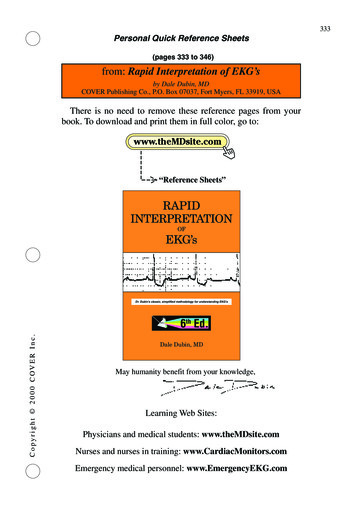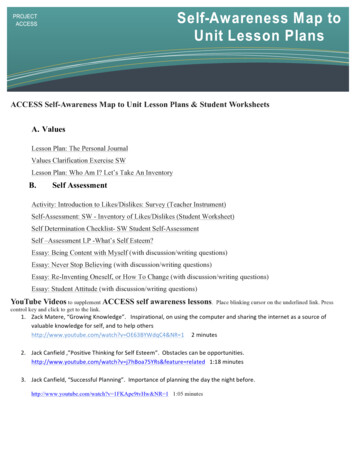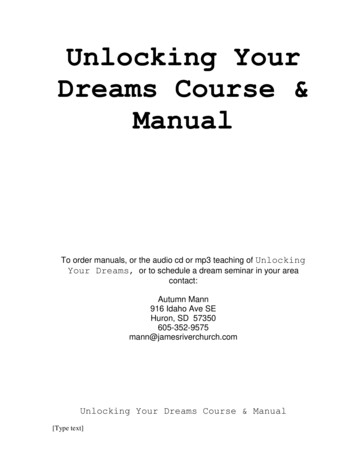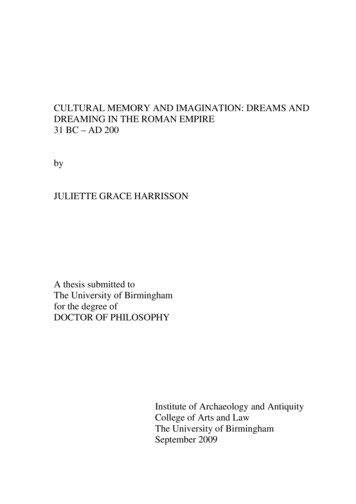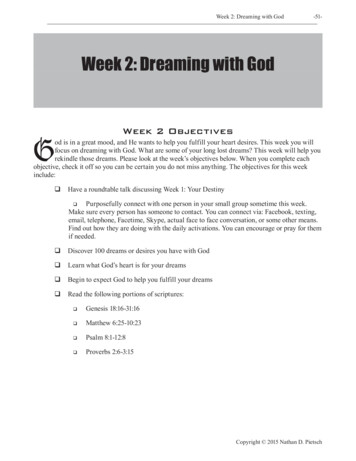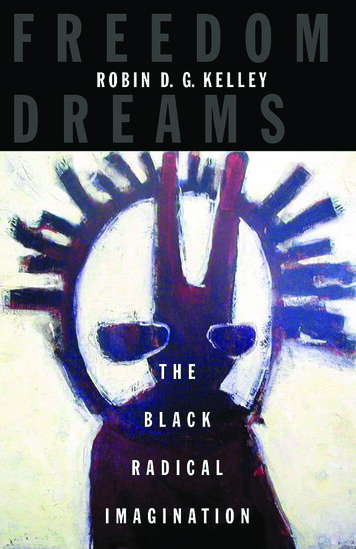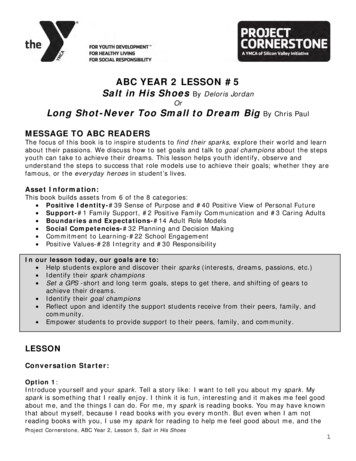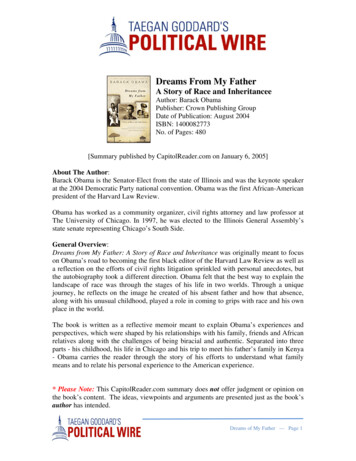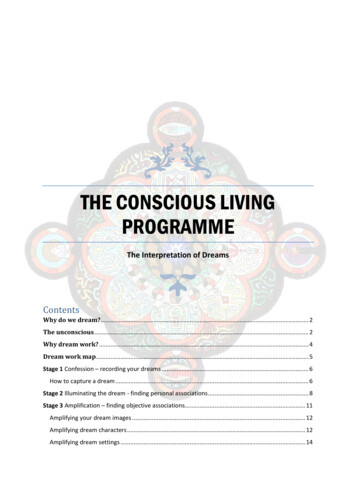
Transcription
THE CONSCIOUS LIVINGPROGRAMMEThe Interpretation of DreamsContentsWhy do we dream? . 2The unconscious . 2Why dream work? . 4Dream work map. 5Stage 1 Confession – recording your dreams . 6How to capture a dream . 6Stage 2 Illuminating the dream - finding personal associations . 8Stage 3 Amplification – finding objective associations. 11Amplifying your dream images . 12Amplifying dream characters . 12Amplifying dream settings . 14
The ConsciousLiving ProgrammeTheInterpretation ofDreamsStage 4 Education – interpreting the dream message . 15Stage 5 Transformation – making the dream concrete . 18Dream work – an overview . 19Pots of Green Pasta. 19A Message from Dad . 20Dirty Laundry. 21Jung’s Dream House. 22References . 23Quick Dream Interpretation Guide . 24Step 1 Confession . 25Step 2 Illumination . 25Step 3 Amplification. 25Step 4 Education . 25Step 5 Transformation . 25Resources. 26Books . 26Youtube videos . 27Articles . 271 http://appliedjung.comCopyright The Centre of Applied Jungian Studieshttp://facebook.com/Appliedjung
The ConsciousLiving ProgrammeTheInterpretation ofDreamsThe Interpretation of dreamsDreams are the royal road to the unconscious – Sigmund FreudHe who looks outside, dreams; he who looks inside, awakes – Carl Jung‘Dreams are like stars you may never touch them, but if you follow them they will lead you to yourdestiny.’ – AnonymousWhy do we dream?Dreaming helps us to recharge the mind and revitalise the body; but are there moreto dreams?Throughout time, and across cultures and religious beliefs, dreams have capturedour imagination as man instinctively try to decipher their hidden meaning.Sigmund Freud, the father of psychoanalysis viewed dreams as representations ofunfulfilled wishes and desires. He discovered that encouraging people to talk abouttheir dream images and the thoughts that these images prompted in their minds,would reveal the unconscious background to their neuroses, both in what they saidand in what they failed to say. This technique, called ‘free association’ played animportant part in the development of psychoanalysis; for it enabled Freud to usedreams as the starting point from which the unconscious struggles of his patientsmight be explored. Published in his ground-breaking book The Interpretation ofDreams (1900) Freud famously described the dream as ‘the royal road to theunconscious’.The UnconsciousSo what is the unconscious and how do you gain access to its messages?The unconscious was viewed by Freud as a place where forgotten, repressed ordreaded elements of the psyche is stored. Carl Jung, one of the first pioneers intothe mystery of consciousness and its relationship with the unconscious, viewed theunconscious contrarily to his peers. In his autobiography Memories, Dreams,Reflections, Jung describes the story of his life as ‘a story of the self-realisation ofthe unconscious. ‘Everything in the unconscious seeks outward manifestation andthe personality too desires to evolve out of its unconscious conditions and to expressitself as a whole (p 21).’2 http://appliedjung.comCopyright The Centre of Applied Jungian Studieshttp://facebook.com/Appliedjung
The ConsciousLiving ProgrammeTheInterpretation ofDreamsJung saw within the unconscious (the primal pattern) the ‘blue print’ according towhich your conscious mind and your total personality are formed. These patternscontain all the traits, all the strengths, the weaknesses, the basic structure and partsthat make you who you are.Jung viewed the unconscious as the part of the mind that stores all the informationthat is not immediately available to your everyday waking consciousness, but whichaffects your thoughts, feelings and behaviours.It is your unconscious, made up of thousands of stored programmes, that governs your bodily functions such as your breathing, heart rate, kidneyfunction, liver functions etc. determines your instinctive behavioural patterns underpins the beliefs and patterns of your thinking deletes, distorts or filters out incoming information so that you are onlyconsciously aware of information that you need right now.Your unconscious does all of this without the help, supervision or even awareness ofyour conscious mind.Jung discovered that most of the neurosis of modern living – the feeling offragmentation that overtakes us, the loss of meaning, the feeling that we have lost apart of ourselves and that something that once belonged to us is missing, resultsfrom the isolation of consciousness from the unconscious. We all need to consult theunconscious and cooperate with it in order to realise the full potential that lies withinus. When we are in balance, the conscious mind and the unconscious cohabitatesand there is a constant flow of energy and information between these two functions,yet they meet in the dimension of dream, vision, ritual and imagination.As Robert Johnson, in Inner Work so eloquently puts it:‘To get a true sense of who we are, become more complete and integrated humanbeings, we must go to the unconscious and set up communication with it. Much ofourselves and many determinants of our character are contained in the unconscious.It is only by approaching it that we have a chance to become conscious, complete,whole human beings. Jung has shown that by approaching the unconscious andlearning its symbolic language, we live richer and fuller lives. We begin to live inpartnership with the unconscious rather than at its mercy or in constant warfare withit.’ (p.5)3 http://appliedjung.comCopyright The Centre of Applied Jungian Studieshttp://facebook.com/Appliedjung
The ConsciousLiving ProgrammeTheInterpretation ofDreamsWhy dream work?Dreams express the movements, conflicts, interactions and development of the greatenergy system within the unconscious. Dreams are therefore a conversation insymbolic language with yourself; it sends messages between the unconscious andconscious. Through working with your dreams you make it possible for yourself toexplore important parts of your own psyche and you create an opportunity to get toknow yourself better.Dreams provide insight into the way in which you operate in the worldhelp you to examine the recurring patterns playing out in your life and assistsyou to gain insight into the key challenges and choices that these patternsofferprovide insight into areas of your life in which you feel stuckgive insight into your relationships with othersoffer insights into your feelingsenable you to make conscious and wise choicescreate greater self-knowledge and self-understandingprovide awareness of new possibilities and opportunities where previouslyyou saw nonegrant access to personal and meaningful messagescontribute to meaning in your lifecreate personal transformationoffer connections to aspects of yourself that are larger than your egoguide your personal growth and support you to achieve your full potentialSo how do you work with your dreams?In the words of Jung:Collective Works 8, p 00‘The years when I pursued the inner images, were the most important time of mylife. Everything else is to be derived from this. It began at that time, and the laterdetails hardly matter anymore. My entire life consisted in elaborating what had burstforth from the unconscious and flooded me like an enigmatic stream and threatenedto break me. That was the stuff and material for more than only one life. Everythinglater was merely the outer classification, scientific elaboration, and the integrationinto life. But the numinous beginning, which contained everything, was then.’4 http://appliedjung.comCopyright The Centre of Applied Jungian Studieshttp://facebook.com/Appliedjung
The ConsciousLiving ProgrammeTheInterpretation ofDreamsDream work mapThe method of dream analysis used throughout this guide is Jungian in approach;and is built around Jung’s model of transformation.Working with your dreams involves the following. Confession – recording your dreamsDream work begins with capturing the dream by immediately writing it downfor interpretation later (you can also use a voice note). Then write it down assoon as possible. Illumination – finding personal associationsEvery dream is made up of a series of images. The foundation for interpretingdreams is discovering the personal associations and meaning that theseimages hold for you. Amplification – finding objective associationsLooking at dreams through amplification, through an archetypal framework,expands your personal associations into the realm of the objective and allowsyou to discover unexplored depths of your psyche. Education – interpreting the dream messageTranslating your dream images through personal as well as objectiveassociations helps you to discover and interpret the dream’s meaning andconnects the meaning of the dream to the dynamics of your inner life. Transformation – making the dream concreteThe specific images and messages you receive from your dreams areaccompanied by an energy that contains transformative potential; it integratesthe insights or the messages of your dreams into your conscious as well asinto your waking life. The understanding of your dream is no longer on apurely abstract level or for later interpretation – it provides immediate andconcrete reality.5 http://appliedjung.comCopyright The Centre of Applied Jungian Studieshttp://facebook.com/Appliedjung
The ConsciousLiving ProgrammeTheInterpretation ofDreamsStage 1 to 5The following is an exploration into the steps of Jungian dream interpretation withsample dreams.Stage 1Confession – recording your dreams‘A man’s dreams are an index to his greatness’. Zadock RabinwitzDreams come in many forms, lengths and intensities. To understand them and themeaning they have for you personally, they need to be recorded. Patterns andrepeating images are a guide to what your unconscious deems important issues.These become clearer when written down in a dedicated book and kept together.When you start paying attention to your dreams, the unconscious startscommunicating and often the frequency of dreams increase.Some people struggle to record complete dreams and only remember fragments oftheir dreams. Don’t let this worry or stop you from working with your dreams, often asingle image from a dream contains vital information about a current situation andthese fragments are just as meaningful as longer dream sequences.The key to the journaling of dreams is to have a dedicated book on hand next to yourbed. Dreams tend to fade during the day, so capture your dream as soon aspossible. The value you will get from doing this far outweighs the effort, however itdoes require you to be disciplined about recording your dreams.How to capture a dreamWrite the dream down on the left hand page of your journal, and keep the right handside blank for interpretations, comments, sketches and subsequent analyses. Datethe entry and write down the dream in the sequence of events, capturing as muchdetail of the dream as possible.6 http://appliedjung.comCopyright The Centre of Applied Jungian Studieshttp://facebook.com/Appliedjung
The ConsciousLiving ProgrammeTheInterpretation ofDreamsWhen writing down your dream, keep this list handy. place/setting of the dreampeople/players in the dream – both known and unknownpuns and metaphors appearing in the dreamsymbols in the dreamfeelings in the dreamcolour, sounds, smellsmovement of the dreamthe narrative/what happens in the dreamSometimes it is seemingly the most insignificant aspects of a dream that turns out tobe the most revealing. Remember you are not trying to make sense of these imagesyet, so don’t worry about how bizarre they may appear, don’t try and box them into awaking-logic, allow the dream-logic to speak.Capture your dream in the present tense, as if it is currently happening, for example:Date:The king summons his vizierDuring the first stage you just want to capture you dream; avoid trying to analyse ordecipher what your dream might mean. You can also draw images from the dream –frequently this is useful, especially if you are trying to convey something that cannotbe expressed in words.Once you have captured your dream, identify key words in the dream and see if youare able to create a title from these words. This will help you to identify and linkdream themes in future.Having recorded your dream, you are ready to begin the process of illumination andclarification, finding personal associations for your dream images.7 http://appliedjung.comCopyright The Centre of Applied Jungian Studieshttp://facebook.com/Appliedjung
The ConsciousLiving ProgrammeTheInterpretation ofDreamsStage 2Illuminating the dream – finding personal associations‘Dreams are a conversation with oneself, a dialogue of symbols and images that takes placebetween the unconscious and conscious levels of the mind.” David FontanaEvery dream is made up of a series of images and symbols and dream work beginswith discovering the meaning that these images have for you. On the right hand sideof your journal, opposite to the dream you captured, write down the first image thatappears in the dream.For example:The king summons his vizier.KingNext to the image write down your associations with this image – what are thewords, ideas, mental pictures, feelings or memories that pop into your head whenyou think about this image? Draw as many associations with your dream images aspossible.While looking for your personal associations, think about: Where was the dream set? Do you know this place or does it remind you ofany place that you do know? What does it remind you of?Do you know the people in your dream, or do they remind you of anyone youknow? What is your relationship to this person? How would you describe thisperson?What did you see? What does it remind you of? About what does it make youthink?How do you feel in the dream? When have you felt like this before? Whatdoes it remind you of?What were you thinking?What feeling do you have about this image? What words or ideas come tomind when you look at it?8 http://appliedjung.comCopyright The Centre of Applied Jungian Studieshttp://facebook.com/Appliedjung
The ConsciousLiving ProgrammeTheInterpretation ofDreamsWhen looking for associations it is also helpful to look for the idiom or metaphor thedream is expressing, for example: dreaming of someone biting your back alludes to the expression ‘backbiting’.This means talking about and undermining someone who is not present(behind their back) dreaming about ‘taking the bull by the horns’ – an idiom which means dealingdecisively with a difficult situation dreaming of blue could refer to feeling blue, in other words feeling sad ordepressed about something.At this stage you want to link your ideas, perceptions etc. that you have of the dreamimage, using Jung’s directed or controlled dream associations. This includesexploring spontaneous ideas which originates from the dream situation. It isimportant to keep going back to your dream image; as you don’t want to start a chainof free associations, which will lead you away from the dream image.For example:The king summons his vizierKing- a ruler- a person who rules over a territory- the best or most important person orobject/subject in a group- someone in charge- someone rich and powerfulIt is important to realise that dreams are unique, no dream or dream symbol can beseparated from the individual who dreams it. In your dreams, your unconscious iscommunicating with you alone, selecting images and symbols that have meaning toyou and to nobody else. No other individual has your background, your emotions oryour experience. The interpretation of dreams are therefore an entirely personal andindividual matter which can only be interpreted in the context of your own life.9 http://appliedjung.comCopyright The Centre of Applied Jungian Studieshttp://facebook.com/Appliedjung
The ConsciousLiving ProgrammeTheInterpretation ofDreamsThere is no single ‘correct’ symbol interpretation and you can’t consult a dream guideto provide you with dream interpretation – you cannot find the answer to what yourdream is trying to communicate to you outside of yourself – dream symbols cannotbe classified.You will experience a feeling of appropriateness or recognition (‘this is right’) whenyou find the correct association to your dream image – it will make complete senseto you. Looking back at the dream snippet shared, your ideas and associations for‘king’ may be different to mine, as the image probably has a different meaning ormessage for you.Repeat this process for each image in the dream.The king summons his vizier.King- a ruler- a person who rules over a territory- the best or most important person orobject in a groupSummons- to call- an order to appearVizier- the king’s main adviser or servant orsteward- a helperAs you work through your personal associations with your dream images you may atcertain times experience that you just can’t connect the image with a personal10 http://appliedjung.comCopyright The Centre of Applied Jungian Studieshttp://facebook.com/Appliedjung
The ConsciousLiving ProgrammeTheInterpretation ofDreamsassociation; or you may feel that your personal associations are not adequatelyconveying your sense of what the dream image means. This is when you need tocontinue to the next stage of dream analysis – amplification or finding objectiveassociations.Stage 3Amplification – finding objective associations‘The soul thinks in images.’ AristotleAmplification is a Jungian technique which attempts to expand your personalassociations and personal understanding of your dream images to connect with thecollective unconscious, or as Jung came to call it later in life, the Objective Psyche.By looking at your dreams through amplification; through an archetypal framework,you will find unplumbed depths of your psyche. Yorum Kaufmann, in The Way of theImage advises that by looking at the image objectively, you can avoid being ledastray by your personal, subjective associations.The concept of psychological archetypes is one of Jung’s most useful andprovocative contributions to modern thought. Jung became aware of the archetypeswhen he observed that the symbols that arise in dreams often correspond to imagesthat have appeared in ancient myths, legends and religion, throughout time andacross all cultures. Archetypes are primordial images and symbols found in thecollective unconscious. Each archetype has a unique set of characteristics,motivations and personality traits. Examples of the archetypal images are forinstance the hero, the child or the mother, etc. Jung’s archetypes are not limited tohuman characters; there are also animal archetypes like the serpent and the lion; aswell as objects functioning as archetypes, such as gold, the castle or the forest.Archetypes are inherited, inborn potentials; patterns of thought and emotions whichprovide us with a set of tools, skills, capabilities, lessons, opportunities and potentialfor this lifetime. They form the foundation upon which each individual builds his ownexperience of life, shading them with his unique culture, personality and life events.Since they are unconscious, they cannot be known or experienced in themselvesand can only be known indirectly through examining their effects and theirmanifestations in images and symbols; as well as by examining behaviour, images,art, stories, myths or dreams.11 http://appliedjung.comCopyright The Centre of Applied Jungian Studieshttp://facebook.com/Appliedjung
The ConsciousLiving ProgrammeTheInterpretation ofDreamsAmplifying your dream imagesYou amplify your dream image by moving beyond your personal associations to lookat the attributes of the images, objects, people, animals and archetypes, expressedin your dream images through the lens of myths, legends, fairy tales and ancienttexts.Once you recognise that the dream setting, dream figure or dream symbol isarchetypal and that the image or symbol can be found universally and across allcultures; the next step is to go to the myths or other sources where the samearchetype appears. What does it tell you about this great archetype? What is its rolein your life?As you amplify your dream images, you continue what you have already done inyour personal associations; also write down your amplified associations and seewhat they say about who you are and what forces are at work within you.Amplifying dream charactersJung discovered that whether known or unknown, people in dreams represent someaspect of the dreamer’s personality and are usually projections of some aspect of thedreamer. Common archetypal dream figures that appear include the following. The persona. The word persona comes from the large carved masks worn byGreek actors as they performed before audiences. It actually means ‘to soundthrough’. These masks were not only used to identify the characters in theplay; it also served as primitive megaphones carrying the voice of the actorsto the top benches of the amphitheatre. In the same way our personafacilitates communication between ourselves and the world; and serves as abridge between our ego and the external world. The persona is our publicpersonality, the face we show the world and it also acts as the mask throughwhich we get to know each other and interact. The persona is a compromisebetween what society expects of us and our own inner personal identity.Today, most of us are inclined to identify ourselves with our inner world or atthe very least, with our private selves. The persona is seen as a necessaryevil, a mask that needs to be worn for the world out there. It is this negativitytowards the persona, seen somehow ‘less than one hundred percentauthentic’ that casts it in a poor light. It is the persona that is the truecarrier of our essential being into the world. It is through the persona thatthe world comes to know us, not through our inner life. In dreams, myths andstories the persona is often symbolised by what we are wearing, our clothing,uniforms, animal skins or by our own skin, our nakedness.12 http://appliedjung.comCopyright The Centre of Applied Jungian Studieshttp://facebook.com/Appliedjung
The ConsciousLiving ProgrammeTheInterpretation ofDreams The ego is the centre of consciousness; it is the bearer of our personality, ourconcept of ourselves. It distinguishes us from others and gives us our senseof identity, our ‘I’. The Ego stands at the junction between our inner and outerworlds, performing the function of perceiving meaning and assessing value.The ego provides a sense of consistency and direction in our conscious livesand plays an important part in the development of a healthy psyche. Withoutthe ego there is no driver of the psyche. In dreams, myths and stories, the egois often symbolised by the hero. The shadow represents unknown or little known characteristics of the ego.The shadow is the inferior being in all of us, ‘it wants to do all the things thatwe do not allow ourselves to do’, or that we don’t want to be. It is ouruncivilised desires and emotions, our dark side; those aspects of ourselvesthat exists but which we do not acknowledge or with which we do not identify.It is the unconscious aspect of our personality, usually hidden and repressed.It is all we are ashamed of, such as egotism, laziness, lustfulness,selfishness, greed, envy, anger, rage. Whatever we see as evil, inferior orunacceptable and deny within ourselves becomes part of our shadow. It is inour dreams that we encounter many unsavoury aspects of life and shadowycharacters that in waking life we may shy away from. We learn from depthpsychology that all of these dynamics being acted out in our dreams areaspects of ourselves. In our dream state the conscious censor is sidesteppedand we see directly into the unconscious. Once we learn to interpret andunderstand our dreams we gain a direct line of sight on our shadows. Indreams, myths and stories the shadow is often symbolised by an inferiorfigure – tramp, beggar, servant, drug addict, pervert, thief, gypsy, prostitute orby anything dark and threatening, such as a zombie. The anima/animus. Jung thought that the psyche was inherently anandrogynous entity regardless of the physical gender, containing andembracing both the feminine and masculine. In a woman her contra sexualityis masculine and governs her rational thinking function; we call this theAnimus. A man’s contra sexuality is feminine and governs his irrational feelingfunction and we call this the Anima. In dreams, myths and stories the anima isoften symbolised by a person of the opposite sex to the dreamer; a woman, asister or a cow, a cat, a tiger, a cave, a ship. In addition to a person of theopposite sex, the animus would be symbolised by an eagle, a bull or a lion.13 http://appliedjung.comCopyright The Centre of Applied Jungian Studieshttp://facebook.com/Appliedjung
The ConsciousLiving ProgrammeTheInterpretation ofDreamsAmplifying dream settingsThe unconscious is often thought of as a set of divided rooms where we keep or hidedifferent memories or aspects of ourselves. Opening a door and entering a roomgenerally symbolises a willingness to enter and face areas that are normally hiddenfrom us. These rooms also symbolise aspects of our personality: be aware of thecondition of the room. As the house typically represents the self, an unfinished houseor one in poor repair may be pointing out to the dreamer that work is required onsome aspects of mind or body.Amplifying our dream exampleThe king summons his vizierKing- a ruler- a person who rules over a territory- the best or most important person orobject in a groupObjectively a king refers to whateverrules a territorySummons:-a call-an order to appearObjectively to summons means tocall for someone or somethingVizier- a helper- the kings main adviser or servant orsteward14 http://appliedjung.comCopyright The Centre of Applied Jungian Studieshttp://facebook.com/Appliedjung
The ConsciousLiving ProgrammeTheInterpretation ofDreamsObjectively a vizier is the main helperto the kingIf you are interested in learning more, download our free Applied Jung Lexicon onArchetypes which is available on our website http://appliedjung.com/applied-guideYou have now completed Stage 3 and have identified your personal associationsand objective association with your dream images. In Stage 4, we are now going tolook at interpreting the message of your dream.Stage 4Education – Interpreting the dream message‘A riddle, wrapped in a mystery, inside an enigma.’ Winston ChurchillThe classic error made by beginners in dream interpretation, is to enquire, ‘
The following is an exploration into the steps of Jungian dream interpretation with sample dreams. Stage 1 Confession – recording your dreams ‘A man’s dreams are an index to his greatness’. Zadock Rabinwitz Dreams come in many forms, lengths and intensities. To



